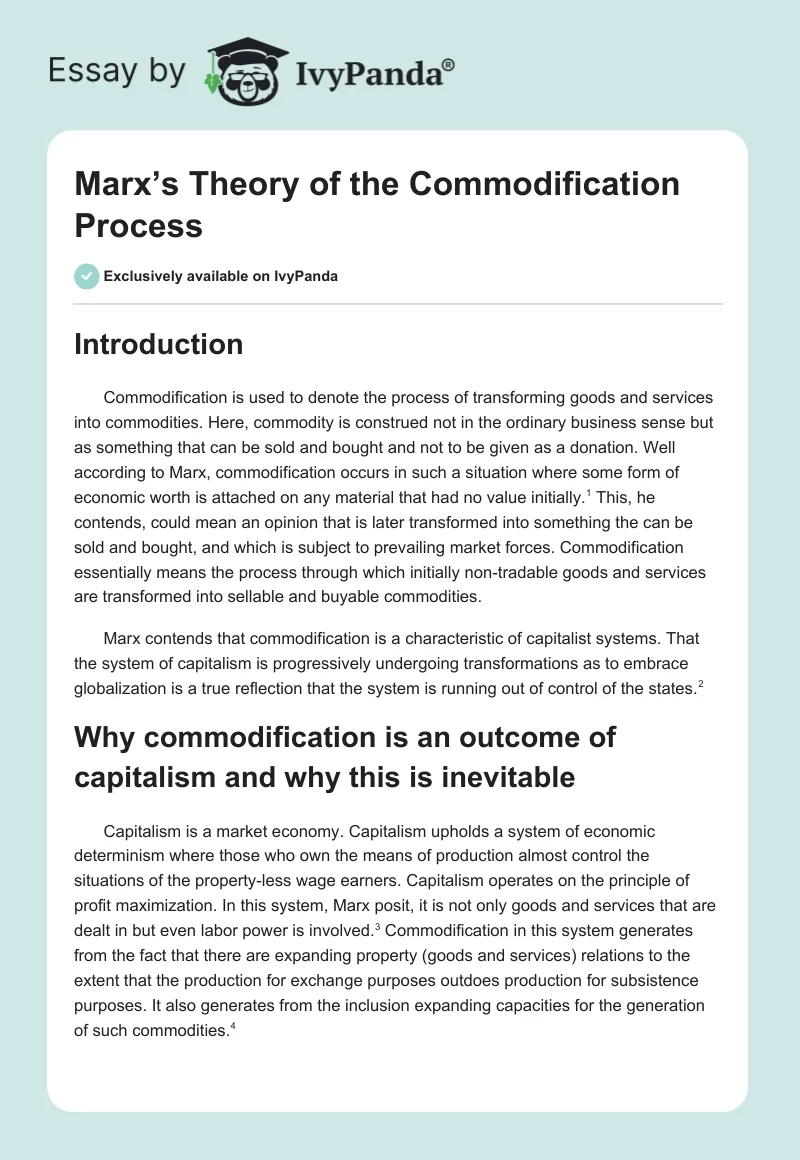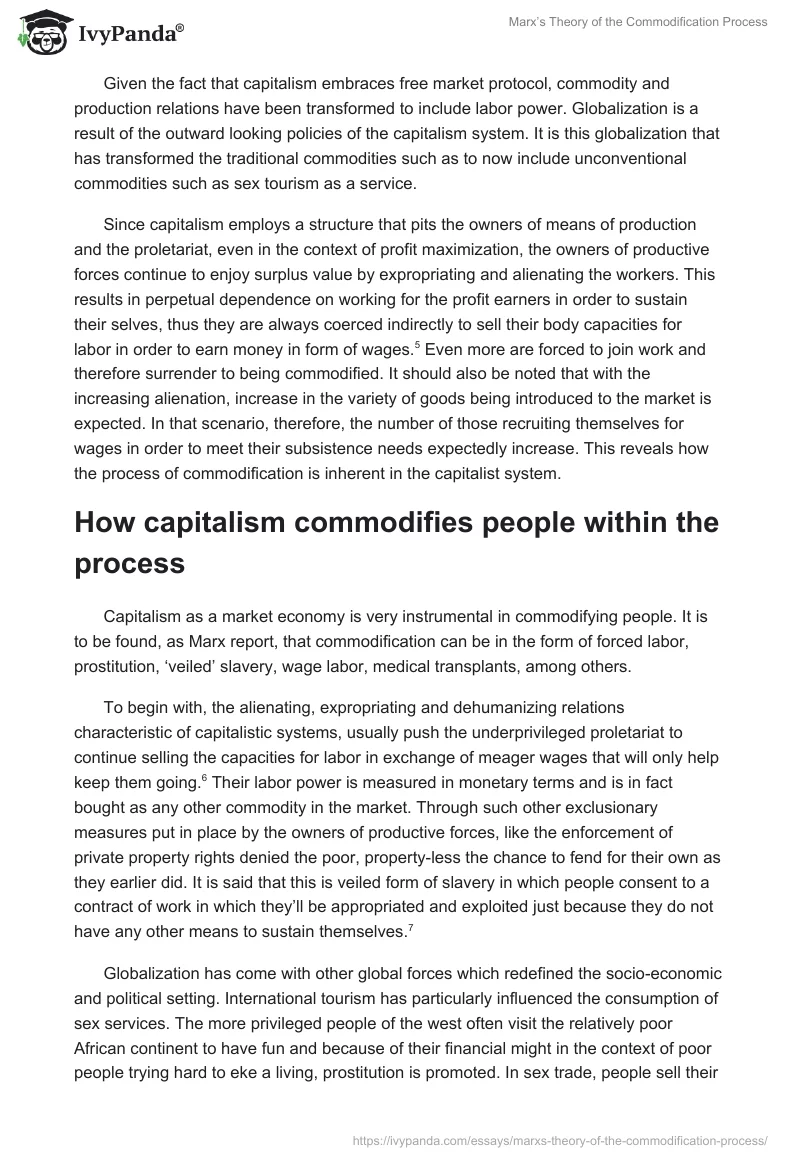Introduction
Commodification is used to denote the process of transforming goods and services into commodities. Here, commodity is construed not in the ordinary business sense but as something that can be sold and bought and not to be given as a donation. Well according to Marx, commodification occurs in such a situation where some form of economic worth is attached on any material that had no value initially. This, he contends, could mean an opinion that is later transformed into something the can be sold and bought, and which is subject to prevailing market forces.
Commodification essentially means the process through which initially non-tradable goods and services are transformed into sellable and buyable commodities. Marx contends that commodification is a characteristic of capitalist systems. That the system of capitalism is progressively undergoing transformations as to embrace globalization is a true reflection that the system is running out of control of the states.
Why commodification is an outcome of capitalism and why this is inevitable
Capitalism is a market economy. Capitalism upholds a system of economic determinism where those who own the means of production almost control the situations of the property-less wage earners. Capitalism operates on the principle of profit maximization. In this system, Marx posit, it is not only goods and services that are dealt in but even labor power is involved. Commodification in this system generates from the fact that there are expanding property (goods and services) relations to the extent that the production for exchange purposes outdoes production for subsistence purposes. It also generates from the inclusion expanding capacities for the generation of such commodities.
Given the fact that capitalism embraces free market protocol, commodity and production relations have been transformed to include labor power. Globalization is a result of the outward looking policies of the capitalism system. It is this globalization that has transformed the traditional commodities such as to now include unconventional commodities such as sex tourism as a service.
Since capitalism employs a structure that pits the owners of means of production and the proletariat, even in the context of profit maximization, the owners of productive forces continue to enjoy surplus value by expropriating and alienating the workers. This results in perpetual dependence on working for the profit earners in order to sustain their selves, thus they are always coerced indirectly to sell their body capacities for labor in order to earn money in form of wages. Even more are forced to join work and therefore surrender to being commodified. It should also be noted that with the increasing alienation, increase in the variety of goods being introduced to the market is expected. In that scenario, therefore, the number of those recruiting themselves for wages in order to meet their subsistence needs expectedly increase. This reveals how the process of commodification is inherent in the capitalist system.
How capitalism commodifies people within the process
Capitalism as a market economy is very instrumental in commodifying people. It is to be found, as Marx report, that commodification can be in the form of forced labor, prostitution, ‘veiled’ slavery, wage labor, medical transplants, among others.
To begin with, the alienating, expropriating and dehumanizing relations characteristic of capitalistic systems, usually push the underprivileged proletariat to continue selling the capacities for labor in exchange of meager wages that will only help keep them going. Their labor power is measured in monetary terms and is in fact bought as any other commodity in the market. Through such other exclusionary measures put in place by the owners of productive forces, like the enforcement of private property rights denied the poor, property-less the chance to fend for their own as they earlier did. It is said that this is veiled form of slavery in which people consent to a contract of work in which they’ll be appropriated and exploited just because they do not have any other means to sustain themselves.
Globalization has come with other global forces which redefined the socio-economic and political setting. International tourism has particularly influenced the consumption of sex services. The more privileged people of the west often visit the relatively poor African continent to have fun and because of their financial might in the context of poor people trying hard to eke a living, prostitution is promoted. In sex trade, people sell their personalities in much the same way as any other commodity is sold and bought in the market.
In the field of medicine, those investors keen on maximizing on profits deal in cosmetics targeting women. Women are seen as to have value in procreation and are marketed as such. Medical engineering also commoditize humans as it seeks to introduce new products in the market. Since everything is produced for market exchange, even blood donated to the hospital is later sold and human body parts are trafficked.
In the place of work, humans are commodified in the sense that they have even been referred as “hands”. This implies a situation in which they are recruited not as human beings but as tools of trade bought to help make the projected profit. This is done in total disregard of the fact that humans produce best when they are humanly and not when forced by physical needs to offer themselves as commodities.
How Capitalism can explain the commodification of women in terms of the human trafficking marketplace – why are women more vulnerable?
Human trafficking is function of economic empowerment and social status. Women are particularly vulnerable to being traded due to their economic disempowerment compared to the male folk. In Africa where this inhumane act is common, property relations does not favor women.
In fact, in most African cultures, women did not hold any property rights meaning they always depended on their males for upkeep. Women are usually disfavored in the labor sector and most of them partake in domestic chores and child labor which increases their chances of being trafficked as they are essentially dehumanized. Here, their sense of having some worth, socially, rests upon the economic usefulness they possess. This explains why women remain vulnerable to being traded on just like commodities.
Arising from the misery that women face with their children, particularly during times of civil strives in Africa; commodification of the female folk has always featured. Media in particular has succeeded in making women the objects of pity and sympathy while gaining from the support they receive from their fan base and from the international community. In fact many journalists have been rewarded for reporting/airing such stories.
The vulnerability of women as sex objects can be seen through the sexual wartime slavery endured by Korean women. With the issue of “comfort women” in the service of Imperial Japanese Army during the World War II can be seen from a perspective a little bit different than the commodification process. After all, slavery during wartime is an aspect that might be viewed in a perspective different than sex tourism. Wartime forces dictate different rules.
Nevertheless, it can be assumed that substituting military power with property rights and a privilege, it can be stated that with Korean women being recruited against their own will, with the participation of Japanese administrative/military personnel is a matter of commodification, regardless of the way it was perceived, i.e. brothels to raise the morale of Japanese soldiers, or sexual abuse of military power.
It should not be assumed that the matter of commodifying women is related to any exceptional conditions related to wartime. It is a practice non-officially institutionalized in the peace time in the society as well. The fact that commodification is concerned with women, more than men, can be explained through social norms and privileges as well. The lower social rank of women is the cause and the consequence of men attitude toward them, as the analysis of gender inequalities in Japan has shown. Such lower rank contributes to making women more vulnerable in general, and in sex trafficking industry in particular. If paralleling such gender inequality to the theory of the commodification process, the perception of women as having less worth initially is the main factor for artificially attaching such worth through commodifying them. Although sex trafficking is an extreme form of such commodification, it can take less severe forms, which nevertheless, present the same principle.
With globalized capitalism being the order of the day, women have been commodified and have become part of the commodity exchange market. This is because globalization has transformed originally production-oriented capitalism to consumption-oriented market system. As such even human desires, represented by male desires, have been commodified. Given this, males have become the targets for other producers of another realm of products and services. Women have particularly been commodified as a result of the need to meet the desires of the males, who have a larger disposable income.
Women also are seen to have some value in the form of procreative usefulness attributable to physique, and are therefore treated as such. The West, in particular, where these slaves are destined has put regulations on who can get employment. However, the job openings in those countries appear to be those in favor of women as opposed to men. Such positions are often found in the entertainment and hospitality industries.
It should be noted, however, that property, as the main foundation of inequality, is one of the main factors in commodification. In that regard, property can be used to explain the reason women East Asia, Southeast Asia, Eastern Europe, Russia, South America, and Latin America are forced to work. Adding to the lower status of women, the women from countries with less income, specifically coming from employment, are tricked into being stripped from any value, through “debt bondage, threats of violence, and other coercive psychological methods to control victims.” Thus, the value added is the sexual services, and it can be assumed that the vulnerability of women is driven by demand.
Conclusion
Though capitalism is projected as to be responsible for biggest share of social and economic misfortunes of this world, capitalism is in fact the most viable and reliable political structure can only stand the test of time.
Works Cited
Chitty, Andrew. “The Direction of Contemporary Capitalism and the Practical Relevance of Theory.” Review of International Political Economy 4.3 (1997): 435-47 Print.
Iida, Keisuke. “Human Rights and Sexual Abuse: The Impact of International Human Rights Law on Japan.” Human Rights Quarterly.26 (2004): 428–53. Print.
Johnson, Walter. “The Pedestal and the Veil: Rethinking the Capitalism/Slavery Question.” Journal of the Early Republic 24.2 (2004): 299-308. Print.
Office to Monitor and Combat Trafficking in Persons. “Country Narratives: Countries G through M”. 2011. Trafficking in Persons Report 2010. The U.S. State Department. 2011.
Photis, Lysandrou. “Globalization as Commodification.” Cambridge Journal of Economics 29 (2005): 769-97 Print.
Sharp, Lesley A. “The Commodification of the Body and Its Parts.” Annual Review of Anthropology 29 (2000): 287-328 Print.
Smith, Robert J. “Gender Inequality in Contemporary Japan.” Journal of Japanese Studies 13.1 (1987): 1-25. Print.
Wonders, Nancy A., and Raymond Michalowski. “Bodies, Borders and Sex Tourism in Globalized World: A Tale of Two Cities – Amsterdam and Havana.” Social Problems 48.4 (2001): 545-72 Print.


